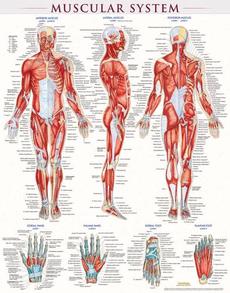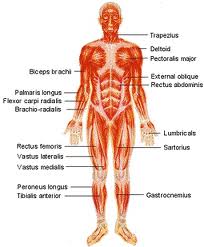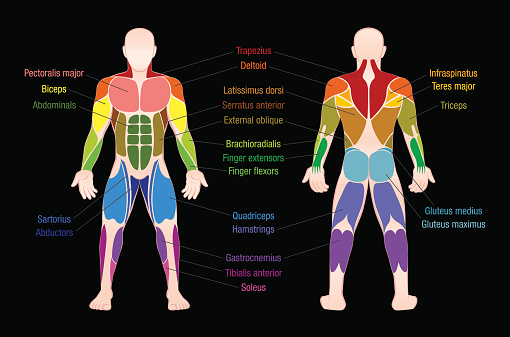40 muscular system no labels
Human Body Systems Quiz With Answers - ProProfs 1. Hairs in the skin belong to which body system? A. Nervous B. Integumentary C. Muscular 2. Which system collects "trash" from the body and also helps with fighting invading pathogens? A. Lymphatic B. Digestive C. Respiratory 3. The eyes belong to which system? A. Nervous B. Muscular C. Integumentary 4. Which organ does not fit with the rest? A. Levels Of Cat Muscle Quiz - ProProfs Ventral Thigh Deep Muscle: Label 1. Related Topics. Muscular System ; Heart ; Human Body ; Leg ; Hand ; Nail ; More Muscle Quizzes. Origin, Insertion, And Action Of Muscles Quiz . Origin, Insertion, And Action Of Muscles Quiz. We've designed here an amazing ' origin insertion and action of muscles' quiz. Check out this quiz and see how well you ...
Shoulder muscles : Anatomy and functions - Kenhub Muscles of the shoulder. Table quiz. Definition and function. Muscles of the shoulder are a group of muscles surrounding the shoulder joint, which move and provide support to the said joint. Muscles. Anterior axio-appendicular muscles : Pectoralis major, pectoralis minor, subclavius and serratus anterior. Posterior axio-appendicular muscles.
Muscular system no labels
What Is the Muscular System? - Study.com Any missing labels on the drawing can be added. The profiles get returned to the original pair of students. They will determine whether or not the other pair was right in their determination of... Anatomy of the spine and back - e-Anatomy - IMAIOS Anterior rami; Ventral rami Anterior sacral foramina Anterior sacroiliac ligament Anterior tubercle Anterior tubercle Anular epiphysis Anulus fibrosus Apex of dens Apex of sacrum Apical ligament of dens Articular facet of the head of the rib Articular facet of tubercle of the rib Atlantooccipital joint Auricular surface Azygos vein Base of sacrum Muscular System Diseases: Overview and More - Verywell Health A muscle disease is any disease that affects the human muscle system. Primary muscle diseases result from abnormalities of the muscles themselves. Secondary muscle diseases are caused by another condition that may have triggered or caused the muscle disease. Both types of diseases affect the muscles and sometimes the nerves that supply them.
Muscular system no labels. Labeled atlas of anatomy: illustrations of the dog - IMAIOS Anatomy of the dog - Illustrated atlas. This modules of vet-Anatomy provides a basic foundation in animal anatomy for students of veterinary medicine. This veterinary anatomical atlas includes selected labeling structures to help student to understand and discover animal anatomy (skeleton, bones, muscles, joints, viscera, respiratory system ... Muscle Origin and Insertion: Definition and Actions - Study.com The human body has over 500 muscles responsible for all types of movement. Each of these muscles has a name; for example, again, the biceps brachii and now the triceps brachii, responsible for both... What Are Voluntary Muscles? - verywellhealth.com Symptoms of neuromuscular disorders include: 3 Muscle weakness Muscle atrophy (wasting) Muscle twitches, cramps, or spasms Muscle pain Numbness and tingling Decreased coordination Droopy eyelids and double vision due to eye muscle weakness Difficulty swallowing due to weakness of the pharynx Difficulty breathing due to weakness of the diaphragm The Human Body: Anatomy, facts & functions | Live Science Each day, the kidneys process about 200 quarts (50 gallons) of blood to filter out about 2 quarts of waste and water. Adults excrete about a quarter and a half (1.42 liters) of urine each day. The ...
Muscular System - Muscles of the Human Body The muscular system is responsible for the movement of the human body. Attached to the bones of the skeletal system are about 700 named muscles that make up roughly half of a person's body weight. Each of these muscles is a discrete organ constructed of skeletal muscle tissue, blood vessels, tendons, and nerves. The Neuromuscular Junction: Function, Structure & Physiology A neuromuscular junction between a motor neuron and skeletal muscle cell. Synaptic transmission includes all the events within the synapse leading to excitation of the muscle. Let me make a quick ... Musculoskeletal system: Main bones, joints & muscles | Kenhub This flexible and movable scaffold is provided by the musculoskeletal system. It is composed of three major structures: bones, joints, and muscles. On this page we'll learn about each of them individually, but also how they all work together as a system to help you accomplish your daily tasks. Contents Main bones of the skeletal system Move Your Muscles! - Lesson - TeachEngineering The muscles are attached to your bones and help you move around. Skeletal muscles are the ones you can see when you flex your arm or leg. Skeletal muscles are also the only muscles that you can move by thinking about them. We call skeletal muscles voluntary muscles because you can volunteer to move them whenever you want to engage (activate) them.
Components of Body Movements: Locomotor, Nonlocomotor & Manipulative Locomotor refers to body movements that move the body from one place to another. They cause the body to travel. There are eight main locomotor movements. They are categorized as either even or... Physiology, Smooth Muscle - StatPearls - NCBI Bookshelf Smooth muscle is present throughout the body, where it serves a variety of functions. It is in the stomach and intestines, where it helps with digestion and nutrient collection. It exists throughout the urinary system, where it functions to help rid the body of toxins and works in electrolyte balance. It is present throughout arteries and veins, where it plays a vital role in the regulation of ... Muscular System: TEAS - || RegisteredNursing.org Circumduction is the muscular and joint movement that entails complete 360 0 movement. Ball and socket joints like those of the hip and the shoulder are capable of circumduction, as shown in the picture above. Involuntary Muscles: Definition, Types, and Examples Voluntary muscles are triggered by the fibers of the muscle, whereas the voluntary muscle get stimuli from outside the nervous system. Example of involuntary muscle are respiratory tract, blood vessel and others. Examples of voluntary muscle are biceps, triceps, pectoral muscle and quadriceps.
Human body systems: Overview, anatomy, functions | Kenhub The muscular system consists of all the body muscles. There are three muscle types; smooth, cardiac and skeletal muscles. Smooth muscle is found within walls of blood vessels and hollow organs such as the stomach or intestines. Cardiac muscle cells form the heart muscle, also called the myocardium.
Learn all muscles with quizzes and labeled diagrams | Kenhub View the muscles of the upper and lower extremity in the diagrams below. Use the location, shape and surrounding structures to help you memorize each muscle. Once you're feeling confident, it's time to test yourself. Unlabeled diagram See if you can label the muscles yourself on the worksheet available for download below.
Anatomical Line Drawings - Medscape Surface Anatomy - lateral views - male. go to drawing without labels. Surface Anatomy - lateral views - female. go to drawing without labels. Surface Anatomy - Child - anterior view & posterior ...
Lab 9: Gross Anatomy of the Muscular System - Anatomy & Physiology: BIO ... Chapter 11: The Muscular System ; Chapter 12: The Nervous System and Nervous Tissue ; Chapter 13: Anatomy of the Nervous System ; Chapter 14: The Somatic Nervous System ; Chapter 15: The Autonomic Nervous System ; Chapter 16: The Neurological Exam ; Chapter 17: The Endocrine System ; AP 1 Lab. AP 1 Lab Atlas ; AP 1 Full Lab Manual
Anatomy, Smooth Muscle - StatPearls - NCBI Bookshelf Unlike skeletal muscle, smooth muscle is capable of maintaining tone for extended periods and often contracts involuntarily. At a cellular level, smooth muscle can be described as an involuntary, non-striated muscle. Smooth muscle consists of thick and thin filaments that are not arranged into sarcomeres giving it a non-striated pattern.
11 Organ Systems | Their Important Functions in Human Body Muscular system This system comprises muscles that are responsible for the movements of the body. They are of three types as skeletal, cardiac, and smooth muscles. Skeletal muscles help in moving the body from one place to another. Functions like walking, running, moving, lifting, bending are possible due to skeletal muscles.
Facial muscles: Anatomy, function and clinical cases - Kenhub Facial muscles (Musculi faciales) The facial muscles, also called craniofacial muscles, are a group of about 20 flat skeletal muscles lying underneath the skin of the face and scalp. Most of them originate from the bones or fibrous structures of the skull and radiate to insert on the skin .
Fourth Grade: MUSKULOSKELETAL SYSTEM (The muscles) Estimadas familias,. Os damos la bienvenida al Blog de las asignaturas bilingües de 4º de primaria.Servirá como herramienta de repaso de los contenidos que vayamos trabajando en el aula a diario. Es recomendable su uso diario para repasar y reforzar desde casa.
Male Reproductive System: Labeled Diagram of Organs - Study.com It is composed of 3 parts: the root, body, and glans. The root is directly attached to the abdominal wall. The body is the cone shaped structure at the end of the penis. the glans is the head of...
Parts of a Frog's Muscular System | Cuteness Cardiac muscle of frogs. The cardiac muscle of frogs is the third type of muscle system in a frog's body. Although it keeps the heart beating automatically, the cardiac muscle looks more like striated muscle than smooth muscle. Cardiac muscle is different from the pectoral or chest muscles of a frog, which are striated. Advertisement.
Muscular System Diseases: Overview and More - Verywell Health A muscle disease is any disease that affects the human muscle system. Primary muscle diseases result from abnormalities of the muscles themselves. Secondary muscle diseases are caused by another condition that may have triggered or caused the muscle disease. Both types of diseases affect the muscles and sometimes the nerves that supply them.
Anatomy of the spine and back - e-Anatomy - IMAIOS Anterior rami; Ventral rami Anterior sacral foramina Anterior sacroiliac ligament Anterior tubercle Anterior tubercle Anular epiphysis Anulus fibrosus Apex of dens Apex of sacrum Apical ligament of dens Articular facet of the head of the rib Articular facet of tubercle of the rib Atlantooccipital joint Auricular surface Azygos vein Base of sacrum
What Is the Muscular System? - Study.com Any missing labels on the drawing can be added. The profiles get returned to the original pair of students. They will determine whether or not the other pair was right in their determination of...














Post a Comment for "40 muscular system no labels"